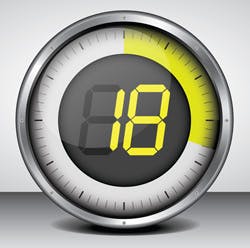Time is money in impressioning
by Ronald D. Perry, DMD, MS
Quick -- how much did impression-taking cost you last month? If your first impulse was to simply pull out your bills and see how much you've been paying for supplies, you may need to reframe your thinking. A close examination reveals the financial impacts of impression-taking involve far more than material costs, and many dentists who seek to cut corners in this area may be costing themselves more in the end.
Do the math
To understand the full cost of impression-taking, we must first factor in chairtime. If we estimate that cord or retraction paste placement and setup take five minutes each, allow one minute each for mixing time and syringing/seating the tray, another five minutes for setting time, and a final minute for evaluation, we can see that the chairtime adds up to 18 minutes for an impression. If you aim for $2,500 of production in an eight-hour day, that means your time works out to a value of $5.21 per minute. Therefore, your cost per impression in time alone is $93.78. Add in the actual material cost of around $7, and you see the real cost of an impression is $100.78.
Based on survey data from the ADA, we can estimate that the average dental practice takes 384 impressions per year -- loosely estimated at 360 crowns, 12 full or partial dentures, and 12 inlay or onlay restorations. If you are taking 384 impressions per year at a real cost of $100 each, that means impressioning costs you $38,400 annually.
So what's the real takeaway? Your time is valuable -- too valuable to waste on taking bad impressions. When you remove an impression tray from a patient's mouth and see that it needs to be retaken, you may initially not think much beyond the momentary hassle. But the truth is, every retake costs you money, and probably more money than you'd guess at first blush.
Making it count
To avoid unnecessary waste on impressioning, I recommend a few critical steps. First, use a reliable impression material. It's easy to be tempted by the initial cost-savings of generic materials, but as we've seen here, just one or two retakes can easily cancel out any material savings with excess costs in your time. I've had experiences in which I was initially impressed with a low-cost material, only to find that the next batch was not as good because of poor quality controls. This has taught me to stick with reliable materials from reputable manufacturers, such as 3M™ ESPE™ Impregum™ Polyether Impression Material and 3M™ ESPE™ Imprint™ 3 VPS Impression Material. High-quality products also ensure optimal accuracy, which ultimately contributes to future time savings when seating and fitting the final restoration.
An additional caution in material selection is to avoid gray market materials. These are brand-name materials that are not purchased through authorized distributors, meaning dentists have no real assurance that they are getting what they think they're getting. Even if the material itself is genuine, there is no guarantee that it has been handled or stored properly, or even that it isn't expired. There are no shortcuts in material selection. To avoid problems, use reputable materials from reputable distributors.
After you've selected the proper impression material, invest the time in absorbing the technique and using it with the proper tools. Again, shortcuts or inattentiveness in technique can easily backfire, costing you money. Ensure that the material is mixed properly, use the proper mixing tip on your gun or automatic mixing device, and follow the instructions for mixing and setting times.
These steps may seem elementary, but I have seen many instances in which poor material selection and poor technique have resulted in a bad impression, and in the end the dentist blames the lab instead of reconsidering his or her own work. The truth is, our time is money, and it is too valuable to waste by neglecting proper impressioning. By recommitting yourself to investing in the best impressioning products, attention to detail and good technique, you can avoid $100 mistakes, ensure that your $38,400 is spent wisely, and contain your impressioning costs year after year.
Ronald D. Perry, DMD, MS, received his DMD from Boston University Goldman School of Dental Medicine in 1988 and graduated with his MS in dental research from Tufts University in 1999. Dr. Perry owns a private practice, Meridian Dental Associates, in South Weymouth, Mass. He can be reached by email at [email protected].
Past DE Issues

